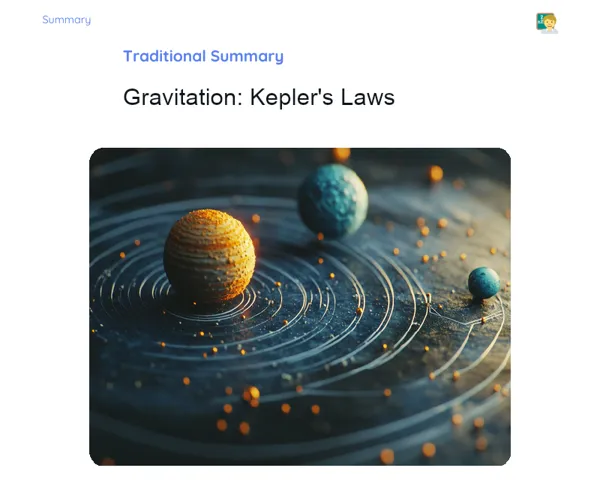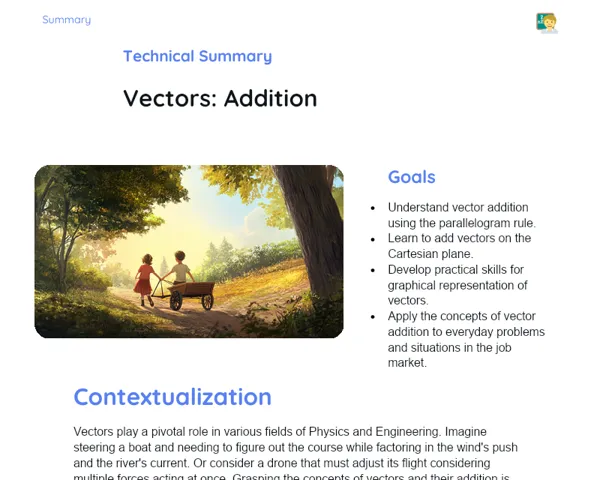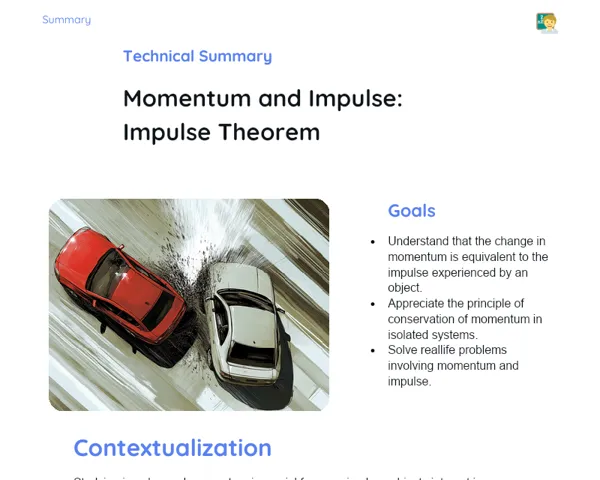Summary Tradisional | Work: Resultant Force
Contextualization
In physics, the idea of a resultant force is really basic as it sets the pace for how an object accelerates, following Newton's second law (F = ma). Practically, the resultant force is nothing but the vector sum of all the forces acting on an object. Knowing how to work out this force is key to predicting and controlling the motion of objects, whether it’s as simple as an apple falling from a tree or as engineered as machines and vehicles operating smoothly.
When it comes to calculating the work done by a force, it is defined as the product of the applied force, the distance over which the object moves, and the cosine of the angle between the force and the displacement direction (W = F * d * cos(θ)). This concept finds its place in many areas, including engineering – vital for ensuring that our structures and devices are built safely and efficiently. Grasping how the force and the angle affect the work done can help us design systems that are not only more effective but also safer.
To Remember!
Definition of Resultant Force
The resultant force is essentially the vector sum of all the forces acting on an object. When an object has multiple forces acting on it, these forces can combine in different ways to produce a single net effect – that is the resultant force. This net force directly influences the object's acceleration as per Newton's second law (F = ma), which tells us that the acceleration is directly proportional to the net force and inversely proportional to the mass of the object.
To compute the resultant force, we need to look at both the magnitude and the direction of each force. If the forces are acting along the same line, then you add or subtract their magnitudes depending on whether they work in the same or opposite directions. However, when the forces act in different directions, especially at right angles, we need to use vector addition, often employing the Pythagorean theorem to combine perpendicular forces.
Understanding this concept is very important, for example, when considering a moving car. The car is affected by forces like engine thrust, air drag, and friction from the road. The net effect of these forces governs the car’s acceleration. In fields such as engineering, designing any structure or system requires a good grasp of the resultant force to ensure everything holds together under various loads.
-
Resultant force is the aggregate vector sum of all forces acting on an object.
-
It is critical in determining the acceleration of the object as per Newton's second law (F = ma).
-
Both the size and the direction of the forces need to be taken into account.
Method for Finding the Resultant Force
To calculate the resultant force in all sorts of situations, you need to follow a systematic approach. Start by identifying all the forces acting on the object as well as their directions. Representing these forces as vectors helps in visualizing both their magnitude and direction clearly.
If the forces are aligned in the same direction, then you can simply add their magnitudes if they work together, or subtract if they work in opposite directions. For forces that are perpendicular, you can use the Pythagorean theorem; the resultant force will be the square root of the sum of the squares of the individual forces.
In more complicated cases, when forces are neither aligned nor perpendicular, you must break them down into their horizontal and vertical components. Sum the components in each direction separately, and then use the Pythagorean theorem to get the magnitude of the resultant force. The direction of this force can then be found by using the tangent function.
-
Identify every force and its direction clearly.
-
Make use of both graphical and analytical methods to add vectors.
-
For complex force systems, decompose them into horizontal and vertical components.
Work Done by a Force
In physics, work is defined as the product of the force applied, the distance over which the object is moved, and the cosine of the angle between the force and the displacement (W = F * d * cos(θ)). This essentially tells us how much energy is transferred to an object through force applied over a distance.
The work done depends on three factors: the size of the force, the distance moved in the direction of that force, and the angle between the force and the movement. When the force is applied exactly in the direction of the object’s motion (i.e. at an angle of 0°), you get maximum work done. But if the force is applied at 90° to the direction of movement, no work is done, as the force doesn’t help in moving the object along its path.
This idea of work is central in physics and finds applications in many fields. For example, in mechanics, the work done by a force determines the change in the object’s kinetic energy. In engineering, accurate computation of work is crucial to design machines and systems that are both efficient and safe.
-
Work is given by the product of force, the distance travelled, and the cosine of the angle between them.
-
It relies on the size of the force, the displacement, and the angle of application.
-
Understanding work is vital to know how energy is transferred by forces.
Importance of Angle in Work Calculation
The angle at which a force is applied relative to the direction of movement plays a critical role in computing the work done. This angle essentially tells us how effectively a force contributes to moving an object. The smaller the angle, the larger the portion of the force that actually pushes the object in the desired direction, thereby increasing the work done.
For instance, if a force is applied in the same direction as the movement (0° angle), the cosine of the angle is 1, meaning all of the force is used in doing the work. On the other hand, if the force is applied at a right angle (90°), the cosine becomes 0, and essentially no work is done since the force does not help in moving the object forward.
This understanding is very useful in practical scenarios. Consider pushing a heavy object on a slope – the efficiency with which you transfer energy depends on the force angle. In engineering, designing machines that apply force in a nearly parallel direction to the motion can lead to much higher energy efficiency.
-
The applied force’s angle determines how efficiently it contributes to moving the object.
-
When the angle is 0°, the work done is maximised, whereas at 90° it is nil.
-
It is important for practical applications to optimise the force's application angle.
Key Terms
-
Resultant Force: The net vector sum of all forces acting on an object.
-
Work: The product of force, the distance an object travels, and the cosine of the angle between the force and the displacement (W = F * d * cos(θ)).
-
Vector Sum: A method to combine vectors that accounts for both their magnitude and direction.
-
Newton's Second Law: A law stating that the acceleration of an object is directly proportional to the net force acting on it and inversely proportional to its mass (F = ma).
-
Calculating Work: The process of finding the energy transferred to an object through an applied force over a distance.
-
Formula W = F * d * cos(θ): The standard formula to calculate the work done by a force.
-
Horizontal and Vertical Components: Breaking down a force into its sideways and upward/downward parts to simplify calculating the resultant force.
-
Pythagorean Theorem: A mathematical rule used to calculate the magnitude of the resultant force when the forces acting are at right angles to each other.
Important Conclusions
This lesson on resultant force and work has provided a solid foundation in these key physics concepts. The resultant force, being the combined sum of all forces acting on an object, determines its acceleration as per Newton’s second law. Learning how to compute the resultant force is indispensable for predicting the motion of objects and is widely applied in areas like engineering and technology.
The explanation of work – defined as the product of force, displacement, and the cosine of the angle between them – is essential for understanding how energy is transferred in any system. Special emphasis was placed on the importance of the angle, which directly affects the magnitude of work done.
For students and professionals alike, mastering these topics is important not only for academic purposes but also for practical applications. This knowledge helps in solving everyday technical problems, such as designing safer structures and more efficient machines, thereby beautifully linking theoretical concepts with real-world applications.
Study Tips
-
Go through practical examples and solved problems from the lesson to cement your understanding of resultant force and work.
-
Make use of extra resources like videos and online simulators which show these concepts in action.
-
Practice with a variety of problems, focusing on different force scenarios and angles, to boost both your calculation skills and theoretical grasp.



